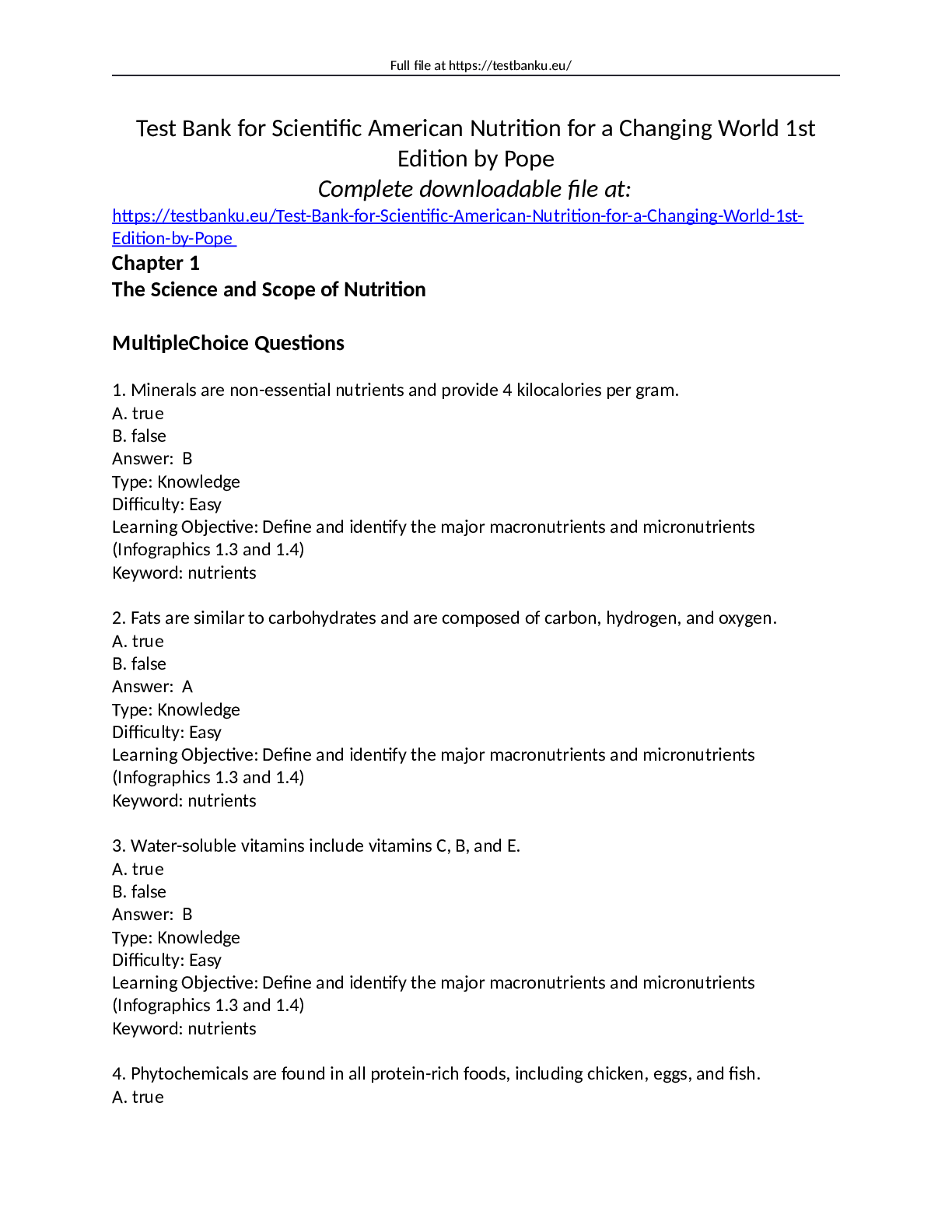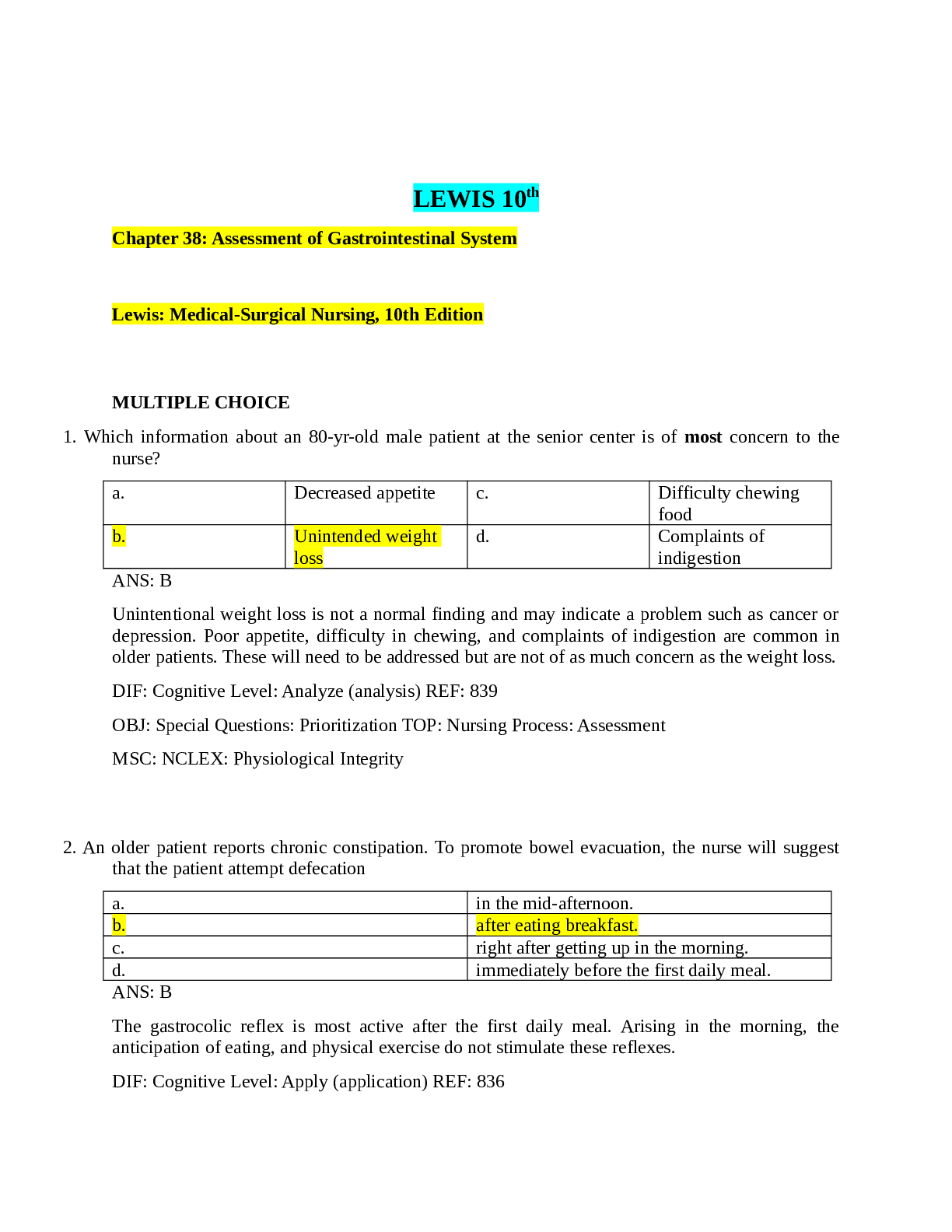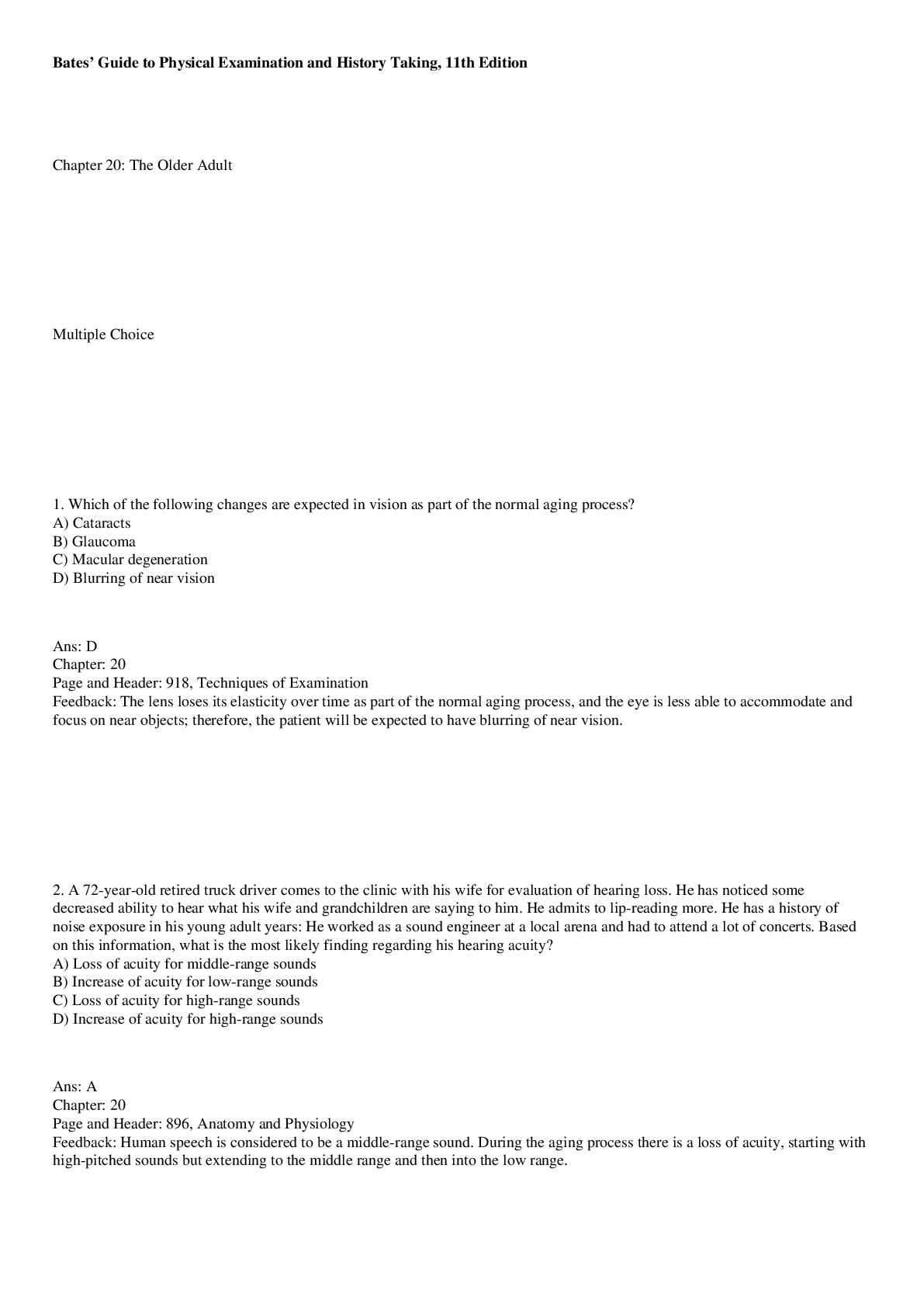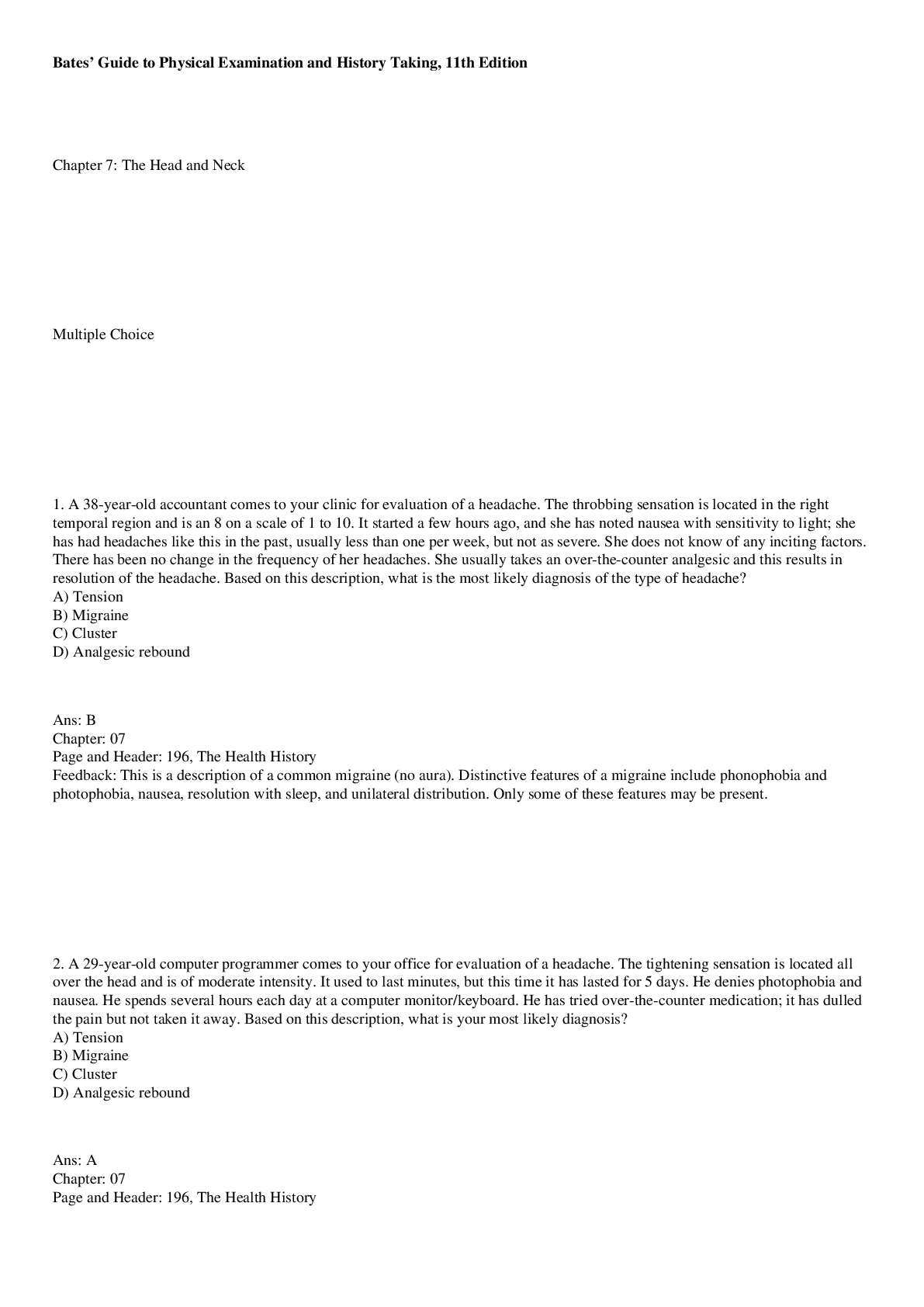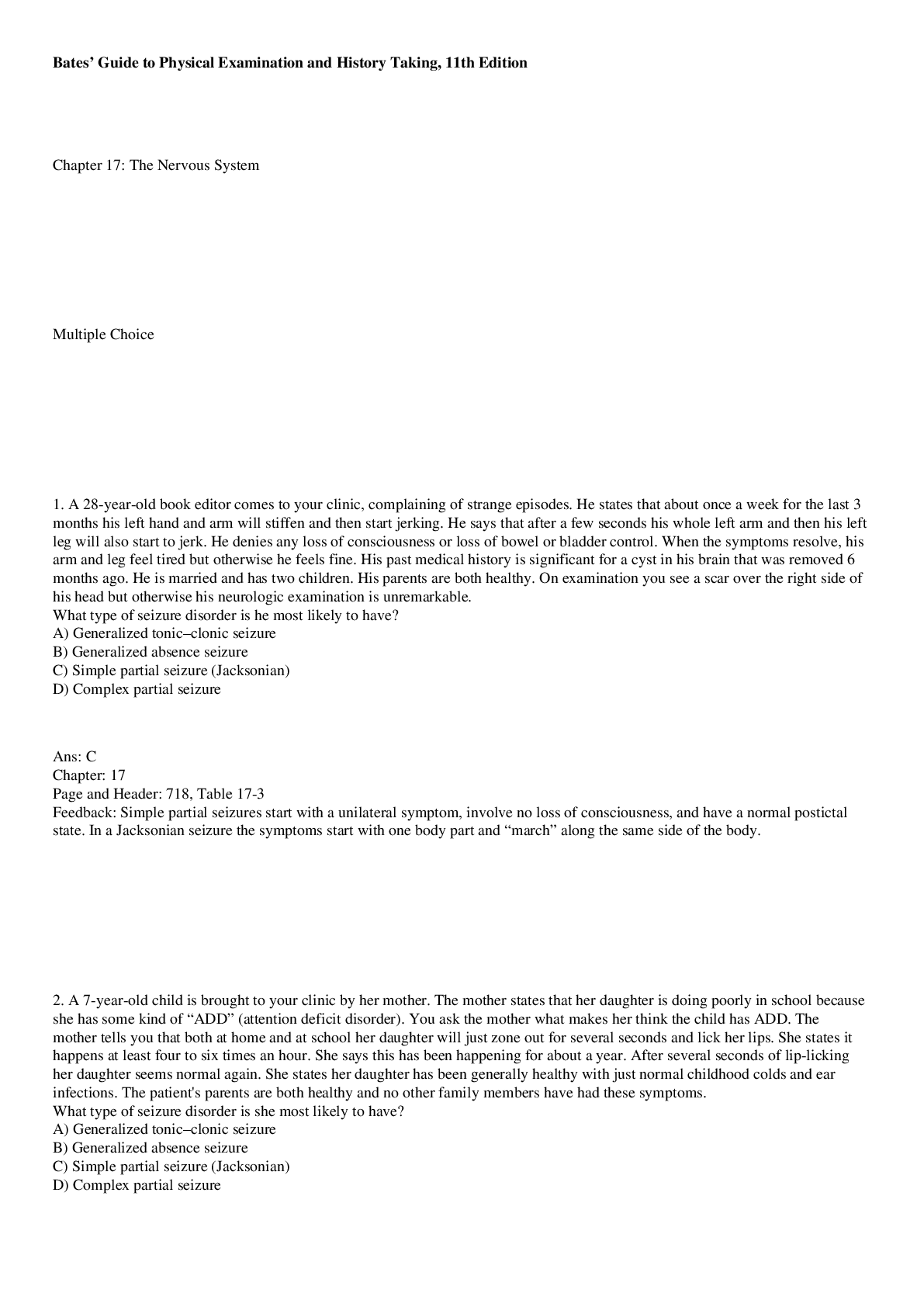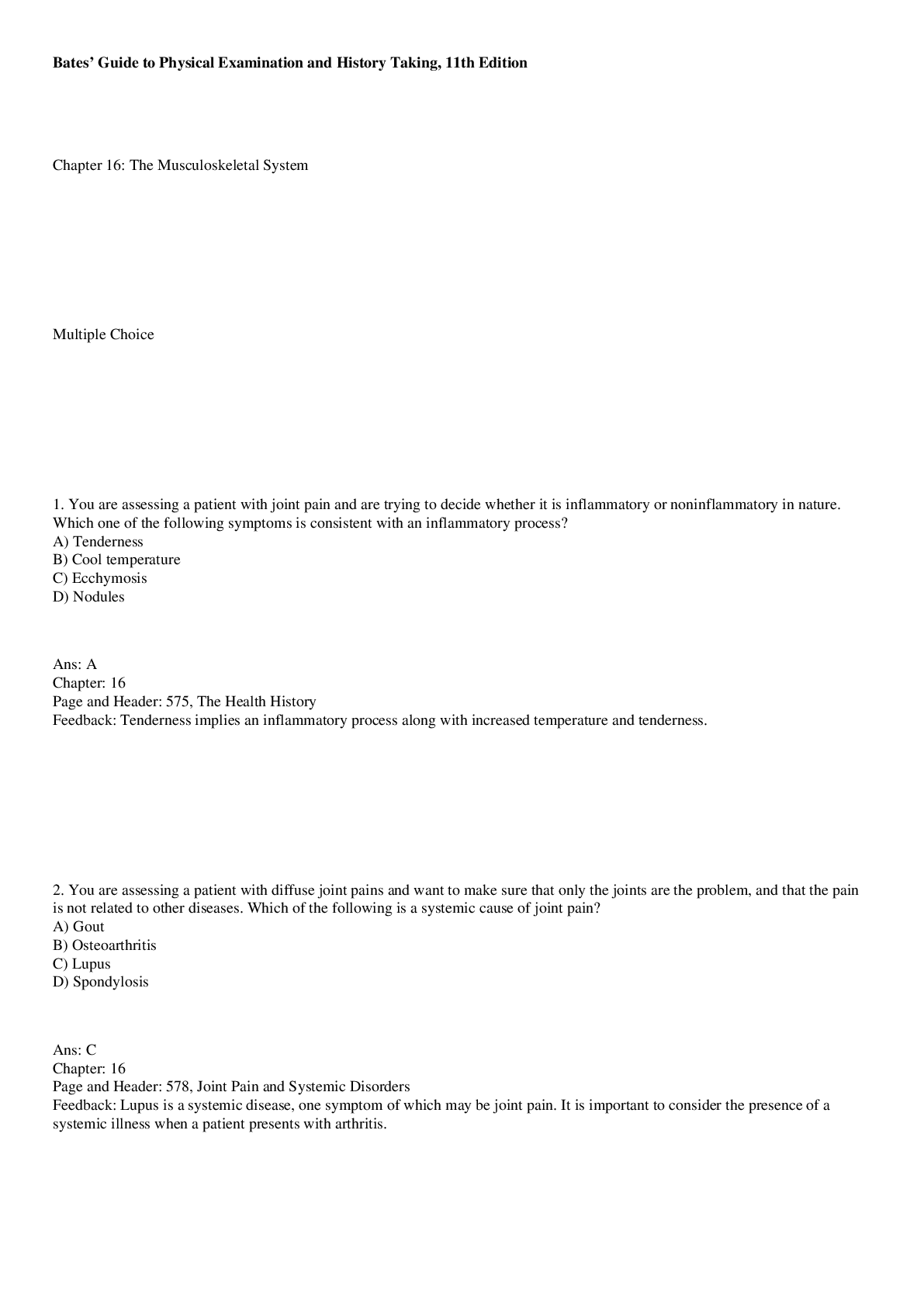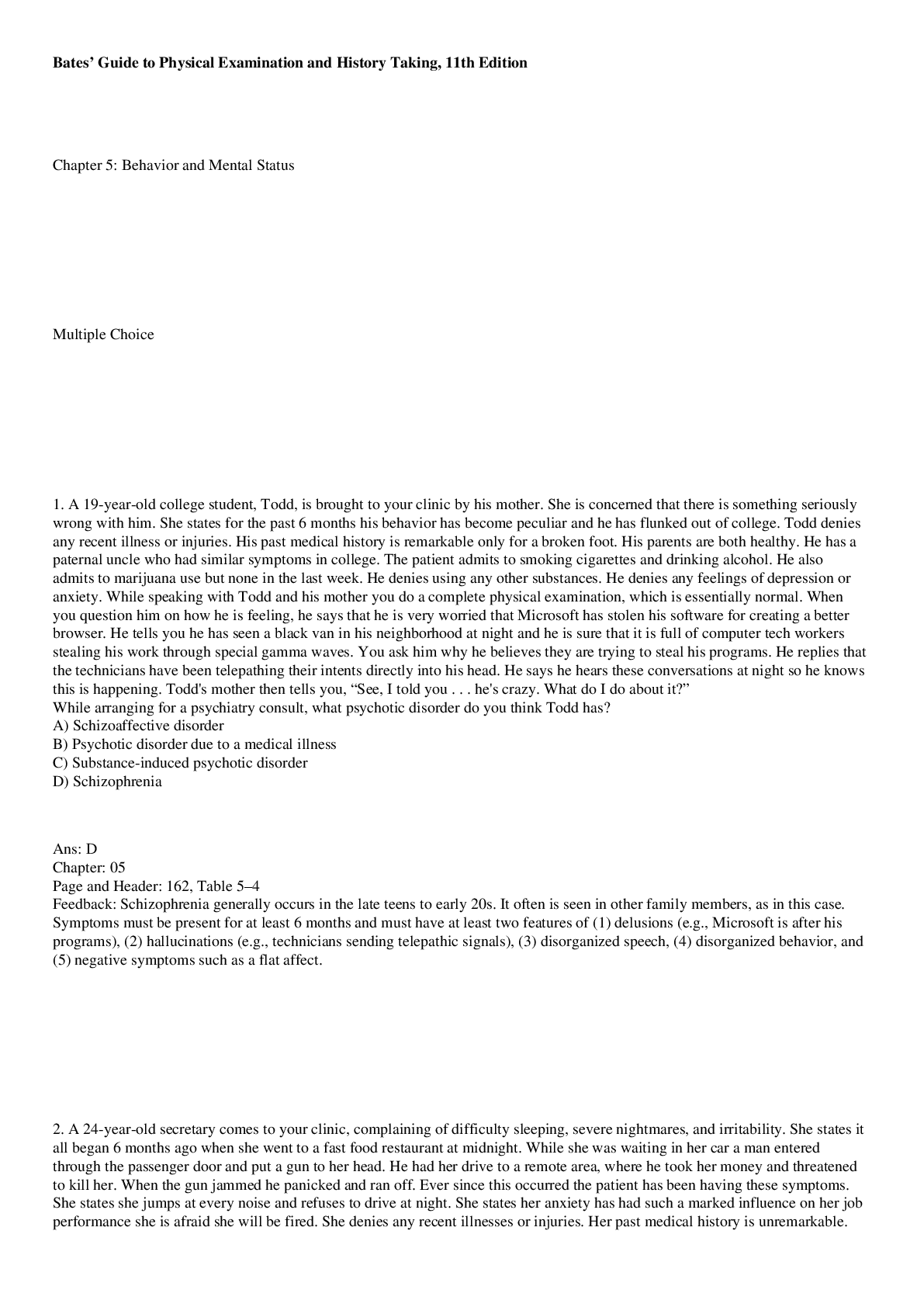*NURSING > TEST BANK > Chapter 2: Evaluating Clinical Evidence ; Bates’ Guide to Physical Examination and History Taking, (All)
Chapter 2: Evaluating Clinical Evidence ; Bates’ Guide to Physical Examination and History Taking, 12th Edition
Document Content and Description Below
Bates’ Guide to Physical Examination and History Taking, 12th Edition Chapter 5: Behavior and Mental Status Multiple Choice 1. A 19-year-old college student, Todd, is brought to your clinic by hi... s mother. She is concerned that there is something seriously wrong with him. She states for the past 6 months his behavior has become peculiar and he has flunked out of college. Todd denies any recent illness or injuries. His past medical history is remarkable only for a broken foot. His parents are both healthy. He has a paternal uncle who had similar symptoms in college. The patient admits to smoking cigarettes and drinking alcohol. He also admits to marijuana use but none in the last week. He denies using any other substances. He denies any feelings of depression or anxiety. While speaking with Todd and his mother you do a complete physical examination, which is essentially normal. When you question him on how he is feeling, he says that he is very worried that Microsoft has stolen his software for creating a better browser. He tells you he has seen a black van in his neighborhood at night and he is sure that it is full of computer tech workers stealing his work through special gamma waves. You ask him why he believes they are trying to steal his programs. He replies that the technicians have been telepathing their intents directly into his head. He says he hears these conversations at night so he knows this is happening. Todd's mother then tells you, “See, I told you . . . he's crazy. What do I do about it?” While arranging for a psychiatry consult, what psychotic disorder do you think Todd has? A) Schizoaffective disorder B) Psychotic disorder due to a medical illness C) Substance-induced psychotic disorder D) Schizophrenia Ans: D Chapter: 05 Feedback: Schizophrenia generally occurs in the late teens to early 20s. It often is seen in other family members, as in this case. Symptoms must be present for at least 6 months and must have at least two features of (1) delusions (e.g., Microsoft is after his programs), (2) hallucinations (e.g., technicians sending telepathic signals), (3) disorganized speech, (4) disorganized behavior, and (5) negative symptoms such as a flat affect. TEST BANK FOR BATES' GUIDE TO PHYSICAL EXAMINATION AND HISTORY TAKING 12TH EDITION BY BICKLEY NURSINGTB.COM This study source was downloaded by 100000831988016 from CourseHero.com on 05-06-2022 10:13:24 GMT -05:00 https://www.coursehero.com/file/64116903/Bates-Guide-to-Physical-Examination-and-History-Taking-12th-Edition-behavior-and-mental-status-cha/ N U R S I N G T B . C O M 2. A 24-year-old secretary comes to your clinic, complaining of difficulty sleeping, severe nightmares, and irritability. She states it all began 6 months ago when she went to a fast food restaurant at midnight. While she was waiting in her car a man entered through the passenger door and put a gun to her head. He had her drive to a remote area, where he took her money and threatened to kill her. When the gun jammed he panicked and ran off. Ever since this occurred the patient has been having these symptoms. She states she jumps at every noise and refuses to drive at night. She states her anxiety has had such a marked influence on her job performance she is afraid she will be fired. She denies any recent illnesses or injuries. Her past medical history is unremarkable. On examination you find a nervous woman appearing her stated age. Her physical examination is unremarkable. You recommend medication and counseling. What anxiety disorder to you think this young woman has? A) Specific phobia B) Acute stress disorder C) Post-traumatic stress disorder D) Generalized anxiety disorder Ans: C Chapter: 05 Feedback: Post-traumatic stress disorder is the fearful response (nightmares, avoidance of areas, irritability) to an event that occurred at least 1 month prior to presentation. The patient's fears and reactions cause marked distress and impair social and occupational functions. 3. A 75-year-old homemaker brings her 76-year-old husband to your clinic. She states that 4 months ago he had a stroke and ever since she has been frustrated with his problems with communication. They were at a restaurant after church one Sunday when he suddenly became quiet. When she realized something was wrong he was taken to the hospital by EMS. He spent 2 weeks in the hospital with right-sided weakness and difficulty speaking. After hospitalization he was in a rehab center, where he regained the ability to walk and most of the use of his right hand. He also began to speak more, but she says that much of the time “he doesn't make any sense.” She gives an example that when she reminded him the car needed to be serviced he told her “I will change the Kool-Aid out of the sink myself with the ludrip.” She says that these sayings are becoming frustrating. She wants you to tell her what is wrong and what you can do about it. While you write up a consult to neurology, you describe the syndrome to her. What type of aphasia does he have? A) Wernicke's aphasia B) Broca's aphasia C) Dysarthria Ans: A Chapter: 05 Feedback: With Wernicke's aphasia the patient can speak effortlessly and fluently, but his TEST BANK FOR BATES' GUIDE TO PHYSICAL EXAMINATION AND HISTORY TAKING 12TH EDITION BY BICKLEY NURSINGTB.COM This study source was downloaded by 100000831988016 from CourseHero.com on 05-06-2022 10:13:24 GMT -05:00 https://www.coursehero.com/file/64116903/Bates-Guide-to-Physical-Examination-and-History-Taking-12th-Edition-behavior-and-mental-status-cha/ N U R S I N G T B . C O M words often make no sense. Words can be malformed or completely invented. Wernicke's area is found on the temporal lobes. 4. A 32-year-old white female comes to your clinic, complaining of overwhelming sadness. She says for the past 2 months she has had crying episodes, difficulty sleeping, and problems with overeating. She says she used to go out with her friends from work but now she just wants to go home and be by herself. She also thinks that her work productivity has been dropping because she just is too tired to care or concentrate. She denies any feelings of guilt or any suicidal ideation. She states that she has never felt this way in the past. She denies any recent illness or injuries. Her past medical history consists of an appendectomy when she was a teenager; otherwise, she has been healthy. She is single and works as a clerk in a medical office. She denies tobacco, alcohol, or illegal drug use. Her mother has high blood pressure and her father has had a history of mental illness. On examination you see a woman appearing her stated age who seems quite sad. Her facial expression does not change while you talk to her and she makes little eye contact. She speaks so softly you cannot always understand her. Her thought processes and content seem unremarkable. What type of mood disorder do you think she has? A) Dysthymic disorder B) Manic (bipolar) disorder C) Major depressive episode Ans: C Chapter: 05 Feedback: Major depression occurs in a person with a previously normal state of mood. The symptoms often consist of a combination of sadness, decreased interest, sleeping problems (insomnia or hypersomnia), eating problems (decreased or increased appetite), feelings of guilt, decreased energy, decreased concentration, psychomotor changes (retardation or agitation), and a preoccupation with thoughts of death or suicide. There must be at least five symptoms for a diagnosis of major depression. This patient has six: (1) sadness, (2) trouble sleeping, (3) overeating, (4) fatigue, (5) difficulty with concentration, and (6) no interest in doing things. 5. A 27-year-old woman is brought to your office by her mother. The mother tells you that her daughter has been schizophrenic for the last 8 years and is starting to decompensate despite medication. The patient states that she has been taking her antipsychotic and she is doing just fine. Her mother retorts that her daughter has become quite paranoid. When asked why, the mother gives an example about the mailman. She says that her daughter goes and gets the mail every day and then microwaves the letters. The patient agrees that she does this but only because she sees the mailman flipping through the envelopes and she knows he's putting anthrax on the letters. Her mother turns to her and says, “He's only sorting the mail!” [Show More]
Last updated: 1 year ago
Preview 1 out of 9 pages
Instant download

Buy this document to get the full access instantly
Instant Download Access after purchase
Add to cartInstant download
Reviews( 0 )
Document information
Connected school, study & course
About the document
Uploaded On
May 06, 2022
Number of pages
9
Written in
Additional information
This document has been written for:
Uploaded
May 06, 2022
Downloads
0
Views
82


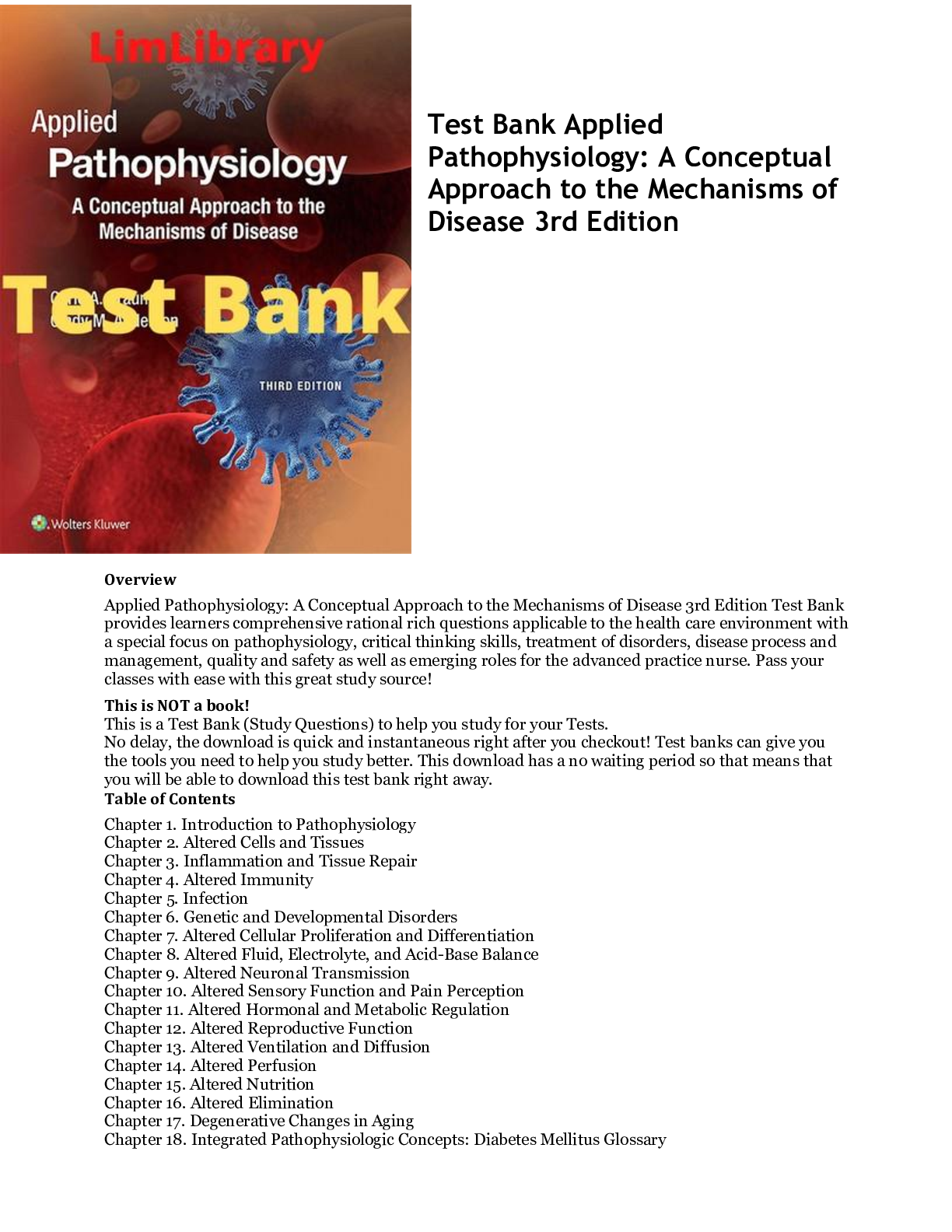

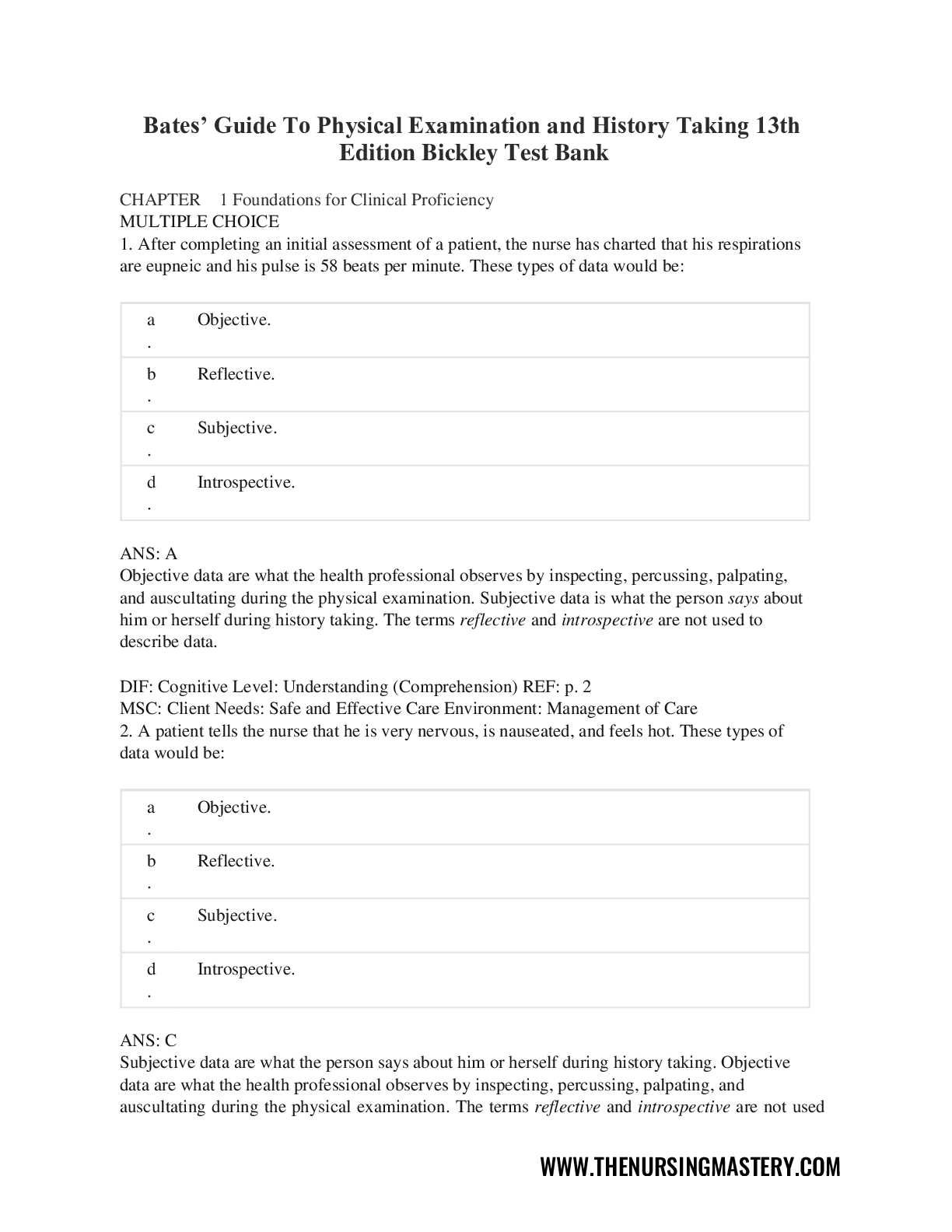
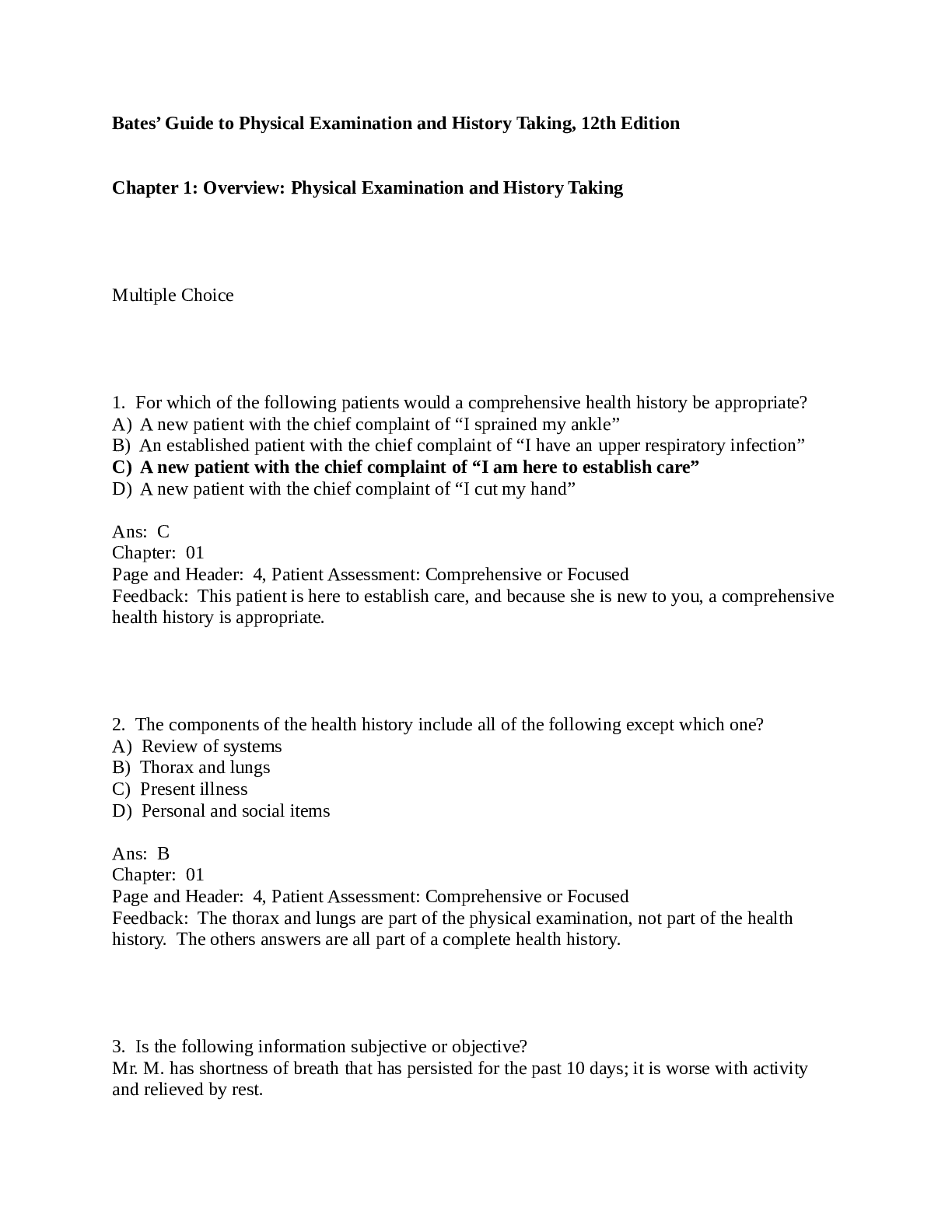
.png)
.png)
.png)

